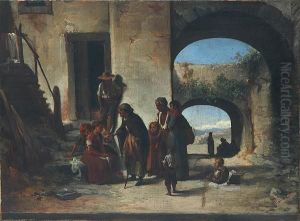Alberto Maironi Da Ponte Paintings
Alberto Maironi Da Ponte was an Italian painter, born in 1722 in Brescia, Lombardy, within the rich artistic and cultural environment of 18th-century Italy. His career spanned a significant period in European art history, marked by the transition from the Baroque to the Rococo, and eventually to Neoclassicism. Despite the prominence of these movements, Maironi Da Ponte developed a distinct style that merged the grandeur of Baroque art with the delicate aesthetics of Rococo. His works are characterized by their intricate details, vibrant colors, and dynamic compositions, which reflect the artist's deep understanding of human emotions and his keen observation of nature.
Maironi Da Ponte was primarily known for his religious paintings, which were commissioned by several churches and cathedrals in Lombardy. These works not only showcase his ability to convey spiritual themes with profound expressiveness but also his skill in creating large-scale compositions that enhance the architectural spaces they inhabit. Alongside his religious paintings, he also produced a number of portraits and landscapes, demonstrating his versatility and keen eye for capturing the essence of his subjects and the beauty of the Italian countryside.
Throughout his career, Maironi Da Ponte remained closely connected to his hometown of Brescia, where he contributed significantly to the local art scene. However, his work also gained recognition beyond his native city, attracting patrons and admirers from across Italy and Europe. Despite his success, there are few records of his life, and many aspects of his biography remain obscure. Nevertheless, his art continues to be appreciated for its emotional depth, technical mastery, and aesthetic appeal.
Alberto Maironi Da Ponte passed away in 1796, leaving behind a legacy that has been somewhat overshadowed by his more famous contemporaries. However, in recent years, there has been a renewed interest in his work, with art historians and collectors alike seeking to rediscover and celebrate his contributions to the Italian Baroque and Rococo periods. His paintings are now considered valuable assets to the collections of museums and galleries that focus on this era of art history, serving as a testament to his skill and creativity.
